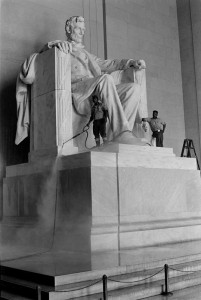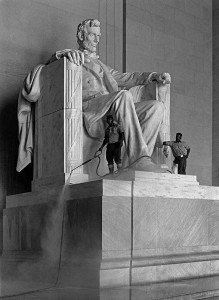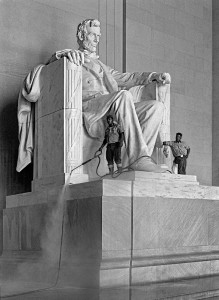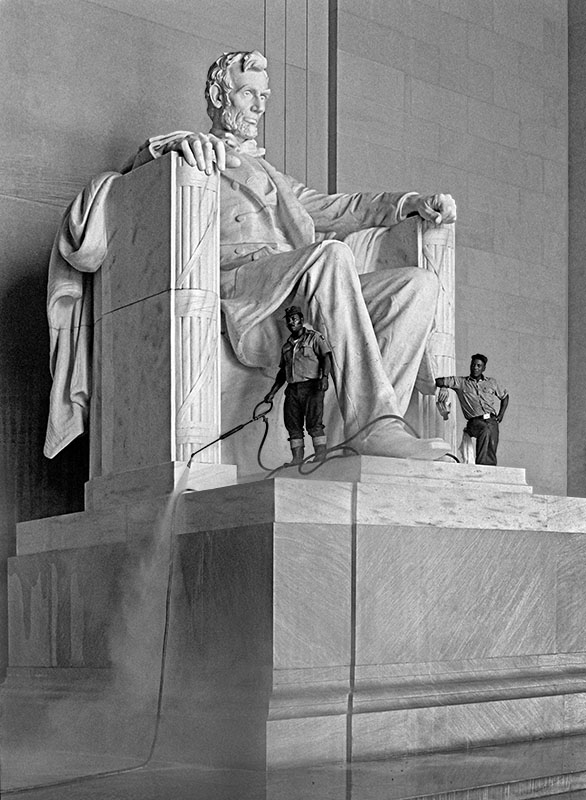I’ve been meaning to do an article on this for years. This week, this image is on sale through The Online Photographer, so I thought I’d better get around to it, in case I might be able to stir up an additional order or two.
I’m simultaneously rather excited and a bit scared about writing this. I’ve had great hopes for this photo since I shot it in 1975, but never got a satisfactory print until 2007 when I had
- A drum scan of the negative
- Photoshop
- Ctein’s help
Ctein wrote a column about that for TOP back in 2007.
I thought the Lincoln Memorial shot had promise at once; it’s marked on the contact sheet with red grease pencil as I did then for things I wanted to try to print. I remember not being able to print it at various stages and with various technologies; but looking at the contact sheet and early scans now, I think at least the first scan is something I could work with. I suppose it’s possible that I’ve learned something about digital printing in the last two decades. Probably other people could have printed it at earlier stages, too.
Then, on top of that, I really wonder if maybe I should have paid for more bits of drum scan (16 bits or higher res?); maybe it could be even better.
Yeah, I’m all wrapped up in getting ready for the start of the sale, which means I’m questioning every decision that it’s too late to change.
However, what I’m actually going to write about here is printing this picture. I’m working largely from memory (Ctein doesn’t tend to create a layer structure that preserves every single decision made as a separate event), but I do have the contact sheet (and negative), Nikon scan, drum scan, and the 2007 and 2014 versions of the edited file, so I have at least some objective evidence of what was done to aid my memory.
How we accomplished things might be of some interest, but what we chose to accomplish, and why, are far more important. Of course I have even less evidence for those; that’s nearly entirely from my memory.
 Which Version?
The problems actually start one step back from where you might think. You see, I have three exposures of the memorial from this trip.

This shows them in backwards order (note the negative numbers at the bottom). So, at the left there is the one I actually printed. In the middle is an even more underexposed version, of no particular interest.
And at the far right is what first caught my eye. It wasn’t just Lincoln and the park workers, it also included the family in the foreground at the left. Unfortunately, it was done in such a hurry that the exposure is awful, and the family is cut off too high (for no good reason, there’s free space at the top), and that guy on the right is a problem, and there’s a guy on the left between us and the family too (I suspect one or two of the spare guys walked into the frame between when I saw the possibility and when I was able to shoot).
So, in the end, there’s no choice, there’s only one version worth working with. You can’t obsess about the ones that got away, because if you shoot people living their lives, a lot of things you see get away over the years.

First Scan
I started with a scan I made myself (Nikon Coolscan LS-2000).
First, you may notice there’s an amount of crap on the negative. That’s easily fixed, if annoying. Also, it mostly looks pretty good; I think my saved file of this is significantly adjusted, not straight.
Also, that the cropping is somewhat different, and that there’s that ladder in the background, and that the perspective is also somewhat different.
I might have been able to make something of this, eventually, but I didn’t at the time.

Drum Scan
So I went ahead and had a drum scan made (some years later).
Even at the small size it looks a bit more flavorful to me (remembering that we’re looking for information to work with in printing here, not finished art!). It’s smoother. Also they either cleaned the neg better than I did, or spotted it a bit.
First time I’d done this, so I probably didn’t give the lab the best instructions, either. What I’ve got is a 40 megabyte tiff file in 8-bit (per channel) RGB, which is a pretty strange choice for the lab to make when scanning a B&W negative.

First Print
When Ctein first got his large-format printer, I was out in California about a week every month for work, so I was visiting fairly frequently. He suggested I bring some image files that we could play with printing, so the next time I went out I did. Came back from that with four prints I believe (four that I still have on my walls, at least), and we worked on a couple of others a bit before moving on. We spent about a day and a half doing that and very little else, which was a blast.
(My usual readers mostly know who Ctein is, but for those who don’t: he is or has been a photographer; custom printer in dye transfer, B&W, and digital; author of two books on printing; and writer for many photo magazines.)
In case you’ve never tried it, I can tell you that you can learn quite a lot sitting for hours with a master printer working on getting photos ready to print. We’ve done this off and on at my computer and his over the years, sometimes just poking at ideas, this one time carrying several images all the way through to making actual large prints (24″ paper, the images are about 20″ wide and 30″ or so long).
Okay, so what all did we do, anyway?
Curves adjustment
I think of this as global contrast adjustments. Treating the picture as a whole, we’re putting the major parts into appropriate tonal relationships.
Perspective correction
The Lincoln Memorial is a masterpiece of neo-classical design. I wanted to present it in the print with that kind of formality, both for its own sake, and because that increases the contrast with the workers standing casually on the statue.
In this case, a bit of straightening plus removing the vertical convergence were required. This is an area where digital printing has it all over darkroom printing; you can do a small amount of perspective correction in the darkroom, but most enlargers make it very annoying, and the physics limits pretty strongly how far you can take it.
If you’re doing this kind of work a lot, it can be worthwhile hauling a view camera around, or at least a perspective control lens, which lets you fix the convergence in the camera. On the other hand, that means you can’t get such shots of anything but static scenes (well, or scenes that can be predicted reliably). With digital, you can get the perspective you want in more dynamic situations.
Local contrast enhancement
Anything from large-radius unsharp masking (with a radius up in the 50-75 pixel range you’re changing the local contrast quite strikingly) to simple dodging and burning to fancier Photoshop tools to additional curves adjustment layers with individual layer masks. I believe we used some techniques to enhance contrast in both shadows and highlights without making the whole picture look flat
Noise (grain) reduction
Another place where digital printing has it all over the darkroom! I think Ctein hit this with Neat Image after playing with the settings a lot. Neat Image has a lot of settings, and I use Noise Ninja (which is simpler and quite effective) myself. Ctein uses both (and other newer things), choosing them for how well they work on the particular problems in a particular image.
Retouching dust
Much simpler in digital than in the darkroom. I don’t have to manually spot each print with a palette of dyes and very very fine brushes, and yes, I’ve done that. (Yes, it’s so easy one can get lazy about cleaning negatives before scanning, which is not good.)
Remove stepladder from background
This level of retouching was done on darkroom prints for advertising photos sometimes (even in color), using air brushes and such, but I would certainly never have tried it. I’m glad to have the ladder gone, though. (I remember removing it was Ctein’s idea. I learned one Photoshop technique I hadn’t known previously watching how he did it, too.)
Dodge out faces of workers
Crop to eliminate distracting foreground steps, chain, pillars
The one thing that’s close to exactly equally easy in darkroom and digital!
Deciding how to crop is black art, mostly. In this picture it’s fairly simple, we’re trying to retain as much image as possible while eliminating a few distractions. Composition is always important, but this is a photo with a strong subject which draws the eye quite easily on its own, we don’t need to do a lot of work to get you to see the important bits here.
Adjust B&W tones in printer driver (somewhat colder black)
I always did prefer the cold-tone Agfa papers. With Epson Ultrachrome printers, in the B&W mode you can easily adjust the B&W image tone in the printer driver, and we turned it modestly to the cold side. I don’t remember numbers.
 Final Outcome
Final Outcome
We re-worked the image when Mike Johnston of The Online Photographer decided (at Ctein’s urging) to offer this as their July print sale (TOP has done a couple of print sales a year for a long time, but is just starting to experiment with having print sale every month).
To really see the final outcome, you need to go over to The Online Photographer and buy a print, but, for purposes of this article, here’s the jpeg we’re using to represent the final print.
Memories of this are more recent, plus the discussion was conducted in email. So I know what we aimed to do better than above, but I’m not nearly as clear on how Ctein achieved the goals since I didn’t see that happen.
So, here are the additional changes we made for the final version.
Lightened much of the image
I think Ctein probably felt, now, that the original print was maybe too dark (though he didn’t have it in front of him when doing the new versions, just the file). But also, for a smaller print, the proper brightness range is different, usually lighter, than for a bigger one, and the print sale prints were going to be smaller than the first print we made in 2007.
Brought out the worker’s faces more
Even after lightening, Ctein could get some more there, so he did.
Eliminated some optical-illusion halo around the worker’s heads
But we got weird illusion halos. But Ctein killed them off.
Reduced spray mist around the feet
In the first proofs I saw, I felt that the side and toe of Lincoln’s shoe, the hose near it, and the left worker’s boots ended up looking funny, low-contrast and weird. I suspect it’s actual spray from a few seconds before still in the air, and hence completely “natural”, but it looked weird, and I think what matters in this kind of print is that it look believable, not necessarily that it be slavishly accurate (obviously for forensic or scientific photos, or even just photojournalism, the rules are different!).
Removed weird effects on the toe of the boot
After the above, it looked bizarre for other reasons, so Ctein messed about until it didn’t. I didn’t see the intermediate state so I can’t be too specific.
Darkened the pedestal
I felt that the big hulking pedestal was drawing too much attention to itself. I didn’t want to crop it out, I wanted Lincoln to be clearly above us and it contributes to that, but I wanted it to draw less attention. Again, we pushed this to the point where some artifacts appeared, which Ctein then had to eliminate.
Brought out the spray on the left side some
Didn’t want to darken the spray or make it less visible while darkening the side, so magic was done.
Conclusion
So, to make it easier to compare, here are the initial scan and the final image side by side.


The list of things done looks long, but I don’t consider this to be an example of “extensive” manipulation. We did take one thing out (the ladder), but it was a background element. Other than that, we did things that were basically “optical” in their results, all of which can be done in the darkroom. It’s just that, when you start writing down every little thing, it ends up being a long list.
